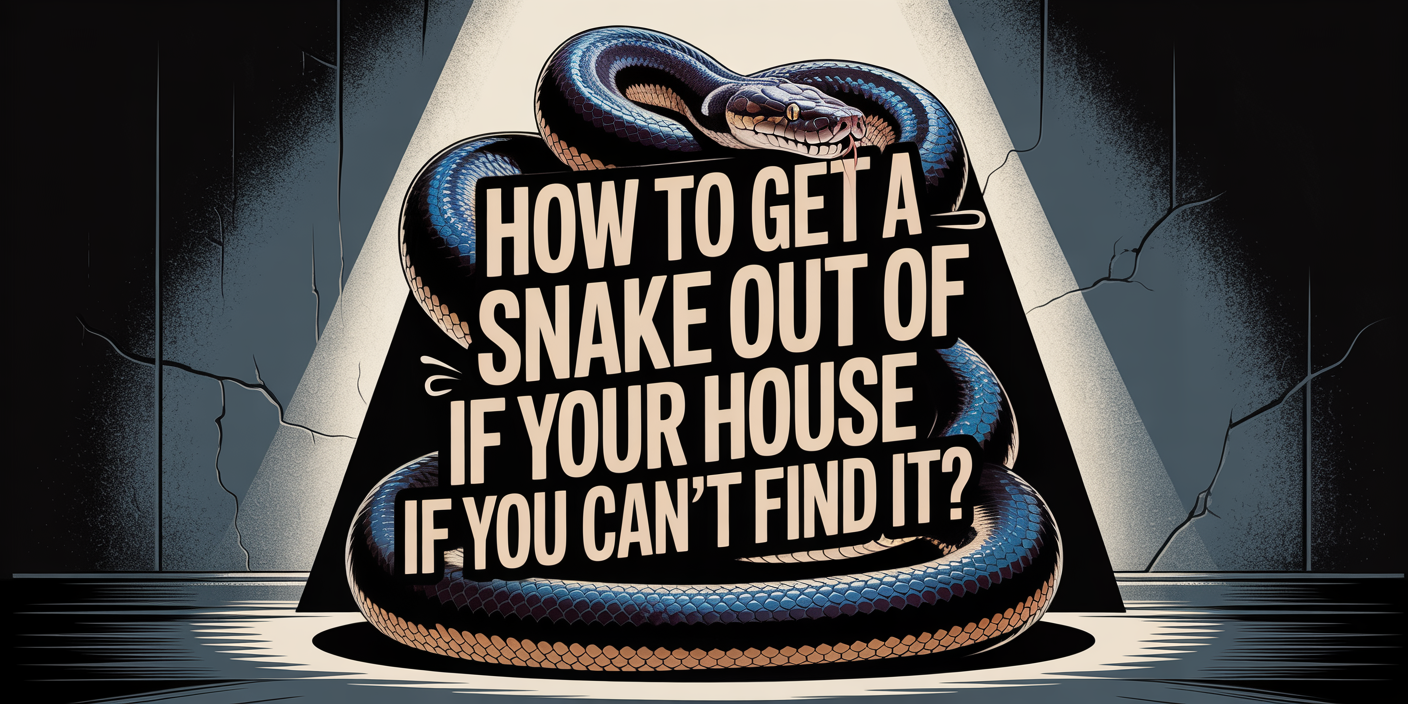If you can’t find a snake in your house, secure all rooms, use scent or sound deterrents like mothballs or vibrations, and call a professional if needed for safe removal.
A snake in your house is enough to send anyone into a panic. But what happens when you can’t even spot it? The fear of not knowing where it is can make the situation worse, but don’t worry; there are specific actions you can take to get the snake out safely, even if it’s hiding.
It’s not just about peace of mind; it’s about ensuring your home remains safe. Snakes can be dangerous, especially if they’re venomous, and if left unchecked, they might cause significant damage or pose a health risk. So, how do you handle the situation when the snake’s elusive? Let’s walk through exactly what to do, step by step, so you can keep your home, and your family, safe.
Understanding Why Snakes Hide and Why You Might Not See It
When a snake enters your home, it’s not likely to make a grand entrance. In fact, snakes are masters at hiding, and their instinct is to stay out of sight. Here’s why you might not see the snake right away:
- Snakes Are Masters of Camouflage
Snakes have evolved to blend in with their surroundings. Their coloring and patterns often mimic the environment, making them nearly invisible in dimly lit or cluttered areas. A dark-colored snake on a dark floor, for example, can be incredibly difficult to spot. - They Seek Tight, Hidden Spaces
Unlike other pests that may roam freely, snakes prefer tight, secluded spaces where they feel secure. Common places include: Behind furniture or appliances, Inside wall cavities or attics, In basements or crawl spaces, Underneath or inside vents and ducts - Low Activity During Daylight
Many snake species are nocturnal, meaning they are most active at night when it’s quieter and darker. If you’ve noticed strange noises or a sudden drop in temperature during the night, the snake might be on the move. During the day, they’ll remain hidden, further complicating your search. - The Element of Surprise
Snakes are cautious creatures. If they feel threatened or disturbed, they’ll freeze, remaining motionless for long periods. This instinct allows them to avoid detection, especially if they feel safe in their hiding spot. - Why They Came In the First Place
Understanding why the snake entered your home can help you figure out where to look. Snakes typically enter homes seeking food (like rodents) or water, or to find a quiet space to cool off or warm up. Knowing this can help you identify their likely hiding spots and limit their access to your home in the future.
By understanding these behaviors and traits, you can better prepare yourself for the task of snake removal. But don’t panic, just because you can’t see the snake doesn’t mean it’s beyond your control. The right approach will bring you closer to solving the problem, one step at a time.
Step-by-Step Guide to Safe Snake Removal When You Can’t Find It
Even if you can’t spot the snake, there are effective ways to remove it from your home. Here’s a detailed guide to follow:
1. Secure Your Space: Prevent Further Movement
First things first, you need to limit the snake’s movement and prevent it from moving further into your home. This will reduce the chances of the snake slipping into an area where it’s even harder to find.
- Close doors and block off rooms: Isolate the area where you suspect the snake might be. Close all the doors to other rooms and keep pets or children out of the area.
- Seal vents and ducts: Snakes can slip into air ducts, so seal off any vents, registers, or openings. This prevents the snake from escaping into areas like walls or the attic.
- Check for hidden cracks or gaps: Inspect baseboards, walls, and floors for small gaps where the snake could crawl into. Use temporary sealants, tape, or other barriers to block these off.
By limiting the snake’s movement, you’ll keep it in a manageable area, making it easier to track and remove.
2. Use Scent and Sound to Your Advantage
Snakes have a sensitive sense of smell and are quite responsive to certain stimuli. By using specific scents and sounds, you can encourage the snake to come out of hiding without direct confrontation.
- Mothballs or ammonia: The strong odor of mothballs or ammonia can be a deterrent for snakes. Place these around the areas where you suspect the snake might be hiding. Be cautious with mothballs, as they can be harmful to children and pets.
- Create vibrations or sounds: Snakes are sensitive to vibrations. Try tapping gently on walls or floors, which may cause the snake to move out of its hiding spot. You can also use a vibrating tool or even loud music to disturb it.
These methods are not foolproof, but they can be effective in coaxing a snake out without needing to directly confront it.
3. Wait and Watch: Let the Snake Come to You
Sometimes, the best course of action is to give the snake some time. After securing the area and using scent or sound techniques, sit back and observe.
- Set up a safe viewing position: With the snake contained in a limited area, wait in a spot where you can monitor any movements. Be patient, snakes are generally shy and will likely come out of hiding when they feel safe again.
- Use non-toxic bait: Place items like food or water in the suspected area to lure the snake out. Some snakes may be attracted to small rodents or even water dishes, especially in dry homes. However, this method requires patience as the snake may not be immediately attracted.
This step can take time, but allowing the snake to come to you minimizes the risk of it becoming more stressed or defensive.
4. When to Call a Professional
If these methods don’t work or if you’re not comfortable attempting to remove the snake yourself, it’s time to call in a professional. Here’s why:
- Handling risks: Even non-venomous snakes can bite when threatened. A professional has the training, tools, and knowledge to handle the snake safely, minimizing the risk of injury to both you and the animal.
- Proper removal and relocation: Professionals have the right equipment to safely remove and relocate the snake without harm. They also know the local wildlife regulations and will ensure the snake is taken to an appropriate location.
If you feel unsure or the snake is venomous, it’s always better to err on the side of caution and leave the job to experts like AAAC Wildlife Removal.
How to Prevent Snakes from Entering Your Home in the Future
Once you’ve removed the snake, the next step is to ensure it doesn’t come back. Prevention is key, and there are several ways to make your home less inviting to snakes.
1. Seal All Entry Points
Snakes are opportunistic and will slither into any gaps or cracks they can find. To stop them in their tracks, you’ll need to ensure your home is sealed up tight.
- Inspect doors and windows: Ensure all doors, especially those leading to the outside, close completely and have no gaps. If your window screens are torn or damaged, replace them immediately.
- Seal cracks and gaps: Check around the foundation, pipes, and walls for any cracks or gaps. Use caulk, expanding foam, or weatherstripping to seal these openings, particularly in areas that may be hard to reach, like the attic or basement.
2. Landscape Your Yard for Snake Deterrence
The area around your home plays a big role in whether snakes decide to visit. By making a few simple landscaping changes, you can discourage them from coming near your home in the first place.
- Trim bushes and shrubs: Overgrown foliage provides shelter and food for rodents, which attract snakes. Keep bushes and shrubs trimmed back, especially near the foundation of your house.
- Clear debris: Piles of leaves, wood, or rocks can provide perfect hiding spots for snakes. Regularly clean up your yard and make sure there’s no debris near your house.
- Maintain a dry yard: Snakes are drawn to water sources, so make sure your yard isn’t prone to flooding or pooling water. Fix leaky outdoor faucets and clear away areas where water tends to accumulate.
3. Remove Food Sources
Snakes come for one reason: food. If you can eliminate their food sources, you’ll make your home much less attractive to them.
- Keep rodents at bay: Snakes typically follow rodents, so a rodent-free house is your first line of defense. Use traps or consult pest control services to keep mice, rats, and other small mammals away.
- Avoid leaving pet food outside: Pet food can attract rodents, which will, in turn, attract snakes. Make sure to bring in any pet food at night, and keep it in airtight containers to avoid attracting pests.
4. Install Snake-Proof Barriers
If you live in an area with a lot of snake activity, taking extra steps can help create a snake-proof perimeter around your home.
- Snake-proof fencing: Install fine-mesh fencing around your yard, making sure it’s buried a few inches into the ground. This will prevent snakes from slithering underneath it.
- Gravel or rock borders: Lining the perimeter of your home with a thick layer of gravel or small rocks can deter snakes. They prefer to travel through soft, moist soil and will avoid rough, uncomfortable surfaces.
5. Regular Inspections
Lastly, regular inspections can help you stay ahead of potential snake problems. By keeping an eye on your property, you can identify any vulnerabilities before they become a problem.
- Check your home every season: Inspect your home thoroughly for any new gaps or cracks every few months, particularly before the colder months when snakes may seek shelter indoors.
- Professional snake-proofing services: If you’re unsure about where snakes might be entering, consider hiring professionals to inspect your home and make recommendations for added security.
By following these preventive measures, you’ll significantly reduce the likelihood of another snake getting into your home. Remember, a proactive approach is always better than waiting for the next scare!
Stay Calm and Take Action
Dealing with a snake in your home is no small matter, especially when it’s hidden from sight. But with the right approach, you can safely remove the snake, secure your space, and ensure it doesn’t return. From securing your home to using scent and sound as a deterrent, the steps are straightforward and effective, just remember, patience is key.
By following these methods and keeping your home well-prepared, you’ll not only solve the current issue but also prevent future snake problems. And if the situation ever feels beyond your control, don’t hesitate to call in the professionals, experts like AAAC Wildlife Removal are equipped to handle any snake situation with safety and care.
Get Expert Help from AAAC Wildlife Removal
Dealing with a snake in your home is stressful, and finding it can be even more so. If you’re not sure where to turn or need help with the removal process, don’t hesitate to reach out to AAAC Wildlife Removal. Our expert team is here to ensure the safe and efficient removal of snakes from your home, without the stress or danger.
Get in touch today for a free consultation and let us help you make your home snake-free. With our proven track record and commitment to safety, you can trust us to handle the job with care and professionalism.




